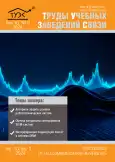Методика автоматического профилирования электрических характеристик подстилающей поверхности на трассе распространения радиоволн диапазона очень низких частот
- Авторы: Типикин А.А.1, Пахотин В.А.1, Потапов Д.С.1
-
Учреждения:
- Научно-исследовательский институт оперативно-стратегических исследований строительства ВМФ ВУНЦ ВМФ «Военно-морская академия имени Адмирала Флота Советского Союза Н.Г. Кузнецова»
- Выпуск: Том 10, № 3 (2024)
- Страницы: 66-73
- Раздел: ЭЛЕКТРОНИКА, ФОТОНИКА, ПРИБОРОСТРОЕНИЕ И СВЯЗЬ
- URL: https://journals.rcsi.science/1813-324X/article/view/259513
- EDN: https://elibrary.ru/MHACGD
- ID: 259513
Цитировать
Полный текст
Аннотация
Об авторах
А. А. Типикин
Научно-исследовательский институт оперативно-стратегических исследований строительства ВМФ ВУНЦ ВМФ «Военно-морская академия имени Адмирала Флота Советского Союза Н.Г. Кузнецова»
Email: alextip@mail.ru
ORCID iD: 0000-0002-0940-4285
SPIN-код: 2114-7517
В. А. Пахотин
Научно-исследовательский институт оперативно-стратегических исследований строительства ВМФ ВУНЦ ВМФ «Военно-морская академия имени Адмирала Флота Советского Союза Н.Г. Кузнецова»
Email: v.pakhotin@mail.ioffe.ru
ORCID iD: 0000-0002-8499-8650
SPIN-код: 3285-1248
Д. С. Потапов
Научно-исследовательский институт оперативно-стратегических исследований строительства ВМФ ВУНЦ ВМФ «Военно-морская академия имени Адмирала Флота Советского Союза Н.Г. Кузнецова»
Email: denpotapow@yandex.ru
ORCID iD: 0009-0008-2289-1576
SPIN-код: 8687-9288
Список литературы
- Coleman C. Analysis and Modeling of Radio Wave Propagation. Cambridge: Cambridge University Press, 2017. 296 p. doi: 10.1017/9781316798607
- Gonzalez G. Advanced Electromagnetic Wave Propagation Methods. Boca Raton: CRC Press, 2022. 708 p.
- Bilitza D. IRI the international Standard for the ionosphere // Advances in Radio Science. 2018. Vol. 16. PP. 1‒11. doi: 10.5194/ars-16-1-2018
- Froń A., Galkin I., Krankowski A., Bilitza D., Hernández-Pajares M., Reinisch B., et al. Towards Cooperative Global Mapping of the Ionosphere: Fusion Feasibility for IGS and IRI with Global Climate VTEC Maps // Remote Sensing. 2020. Vol. 12. Iss. 21. P. 3531. doi: 10.3390/rs12213531
- Galkin I., Fron A., Reinisch B., Hernández-Pajares M., Krankowski A., Nava B., et al. Global Monitoring of Ionospheric Weather by GIRO and GNSS Data Fusion // Atmosphere. 2022. Vol. 13. Iss. 3. P. 371. doi: 10.3390/atmos13030371
- Типикин А.А., Потапов Д.С. Методика оценки электрических характеристик почвы на трассе распространения земных радиоволн // Техника радиосвязи. 2022. № 1(52). С. 19‒29. doi: 10.33286/2075-8693-2022-52-19-29
- Типикин А.А. Методика формирования глобальных цифровых карт электрических характеристик подстилающей поверхности в диапазоне очень низких частот // Информатика, телекоммуникации и управление. 2022. Т. 15. № 1. С. 7‒18. doi: 10.18721/JCSTCS.15101
- Типикин А.А., Парафейник Д.В., Потапов Д.С. Результаты исследований по формированию цифровых картографических данных электрических характеристик подстилающей поверхности в диапазоне СДВ // Морской вестник. 2023. № S1(16). С. 27–29. EDN:JDEEVY
- Morgan R.R. World-wide VLF effective conductivity map. Report 8013F-1 Westinghouse Electric Corporation, 1968. 62 р.
- Рекомендация МСЭ-R P.832-4 (07/2015) Мировой атлас проводимости почвы.
- Башкуев Ю.Б., Ангархаева Л.Х., Буянова Д.Г., Адвокатов В.Р. Прогнозная карта геоэлектрических разрезов континентов земного шара // V Международная научно-техническая конференция «Радиотехника, электроника и связь» (Омск, Российская Федерация, 07–09 октября 2019). Омск: Омский научно-исследовательский институт приборостроения, 2019. С. 17–24. doi: 10.33286/978-5-6041917-2-9.17-24. EDN:DKVXOV
- Типикин А.А. Методика расчета напряженности поля ионосферной волны в диапазоне очень низких частот на основе скачкового метода // Информационно-управляющие системы. 2023. № 5. С. 12–21. doi: 10.31799/1684-8853-2023-5-12-21. EDN:FTXMCY
- Кучмин Н.А., Никитин О.Р. Квантователи речевого сигнала // The Scientific Heritage. 2021. № 81-1(81). С. 46–50. doi: 10.24412/9215-0365-2021-81-1-46-50. EDN:WBHCVJ
- Трубаков А.О., Селейкович М.О. Сравнение интерполяционных методов масштабирования растровых изображений // Научно-технический сборник Брянского государственного университета. 2017. № 1. С. 92–97. DOI:10.22281/ 2413-9920-2017-03-01-92-98. EDN:YHFCGF
- Типикин А.А. Обобщённая методика расчёта напряжённости поля земной волны диапазона очень низких частот для трассы с произвольным количеством однородных участков // Вестник Рязанского государственного радио-технического университета. 2023. № 87. С. 21–28. doi: 10.21667/1995-4565-2024-87-21-28. EDN:NRQFAG
- Дембелов М.Г., Башкуев Ю.Б., Мельчинов В.П. Поле земной волны над протяженными неоднородными радиотрассами // Журнал радиоэлектроники. 2019. № 11. doi: 10.30898/1684-1719.2019.11.11. EDN:NASWEE
- Рекомендация МСЭ-R P.368-9 (2007) Кривые распространения земной волны для частот между 10 кГц и 30 МГц.
- Pal S., Basak T., Chakrabarti S.K. Results of Computing Amplitude and Phase of the VLF Wave Using Wave Hop Theo-ry // Advances in Geosciences. 2011. Vol. 27. PP. 1–11. doi: 10.1142/9789814355414_0001
- Gasdia F., Marshall R.A. A New Longwave Mode Propagator for the Earth-Ionosphere Waveguide // IEEE Transactions on Antennas and Propagation. 2021. Vol. 69. Iss. 12. PP. 8675‒8688. doi: 10.1109/TAP.2021.3083753
- Marshall R.A., Wallace T., Turbe M. Finite-difference modeling of very-low-frequency propagation in the Earth-ionosphere waveguide // IEEE Transactions on Antennas and Propagation. 2017. Vol. 65. Iss. 12. PP. 7185–7197. doi: 10.1109/TAP. 2017.2758392
Дополнительные файлы






